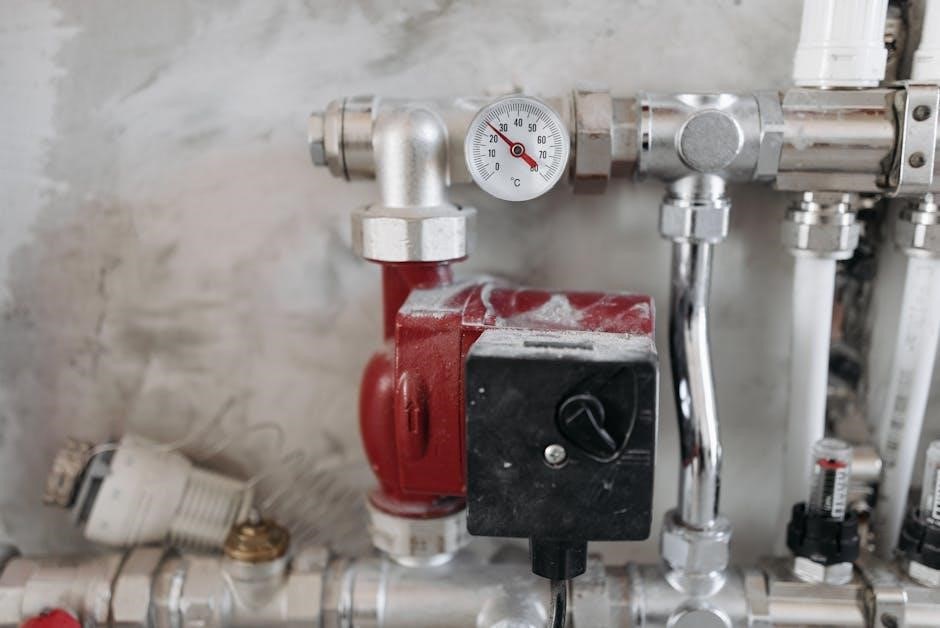Valve guide cutters are specialized tools used to machine valve guides in engines‚ ensuring proper fitment of valve stems for optimal engine performance and longevity.
1.1 Definition and Purpose
A valve guide cutter is a specialized machining tool designed to accurately cut and shape valve guides in engine cylinders. Its primary purpose is to ensure precise fitment of valve stems‚ maintaining proper engine performance‚ and preventing issues like oil leakage or poor compression. The tool’s precision is crucial for both engine repair and manufacturing processes in the automotive industry.
1.2 Importance in Engine Maintenance
Valve guide cutters play a critical role in engine maintenance by ensuring valve guides are accurately machined‚ which prevents excessive wear on valve stems and engine components. Properly fitted guides reduce oil consumption‚ prevent smoke emissions‚ and maintain compression‚ directly contributing to engine efficiency‚ longevity‚ and overall performance. Their use is essential for both routine repairs and major overhauls in automotive and industrial applications.
Types of Valve Guide Cutters
Valve guide cutters are categorized into single-angle‚ multi-angle‚ and adjustable types‚ each designed for specific machining requirements‚ ensuring precision and versatility in engine repair applications.
2.1 Single-Angle Cutters
Single-angle cutters are designed for machining valve guides with a fixed‚ specific angle‚ typically 45 degrees. They are ideal for standard engine repairs where consistency and precision are crucial. These cutters are cost-effective and widely used in automotive maintenance due to their simplicity and reliability in achieving accurate results.
2.2 Multi-Angle Cutters
Multi-angle cutters offer versatility by allowing adjustments to different cutting angles‚ catering to various engine specifications. This feature is particularly useful in high-performance or custom engine setups where unique geometries are required. Their adaptability makes them a preferred choice for workshops handling diverse repair jobs‚ ensuring precise and efficient valve guide machining across different applications.
2.3 Adjustable Cutters
Adjustable cutters provide flexibility by allowing precise modifications to the cutting diameter and angle. This feature is ideal for re-machining worn valve guides to restore proper clearances. Their versatility minimizes the need for multiple tools‚ making them cost-effective for engine repair shops. Adjustable cutters are particularly useful in situations where exact specifications vary‚ ensuring optimal performance and extending engine life;
How Valve Guide Cutters Work
Valve guide cutters use a rotating cutter to precision-machine valve guides‚ ensuring proper fitment of valve stems. The cutter is guided by a pilot‚ maintaining alignment for accurate machining.
3.1 Basic Operating Principles
Valve guide cutters operate by using a pilot to align with the valve seat‚ ensuring precise machining. The rotating cutter removes metal to achieve the desired guide dimensions. Proper alignment and controlled feed rates are essential for accurate results and to prevent damage to the engine head or valve components.
3.2 Machining Process Overview
The machining process involves centering the cutter on the valve seat‚ advancing it into the guide‚ and removing material to specified tolerances. The cutter’s geometry ensures a precise‚ concentric finish. Coolants are often used to maintain tool life and prevent overheating‚ ensuring a smooth‚ accurate cut throughout the operation.

Materials and Construction
Valve guide cutters are typically made from high-speed steel or carbide‚ materials chosen for their durability and ability to maintain sharpness during machining processes.
4.1 Common Materials Used
Valve guide cutters are typically constructed from high-speed steel (HSS) or tungsten carbide. These materials are chosen for their hardness‚ wear resistance‚ and ability to maintain sharp cutting edges. HSS is cost-effective and suitable for most applications‚ while carbide offers superior durability for high-precision or heavy-duty machining. Both materials ensure optimal performance and longevity of the cutters.
4.2 Coatings and Surface Treatments
Valve guide cutters often feature coatings like titanium nitride (TiN) or diamond-like carbon (DLC) to enhance durability and reduce wear. These coatings improve thermal resistance‚ prevent corrosion‚ and minimize friction during machining‚ extending tool life and maintaining precision. Additional surface treatments‚ such as nitriding or chrome plating‚ can further enhance hardness and corrosion resistance. These treatments ensure optimal performance in demanding engine repair environments.

Applications of Valve Guide Cutters
Valve guide cutters are essential in automotive‚ industrial‚ and marine sectors for precise engine repairs‚ ensuring proper valve alignment and optimal performance across various machinery and vehicles.

5.1 Automotive Industry
In the automotive industry‚ valve guide cutters are crucial for engine overhauls. They ensure precise machining of valve guides‚ maintaining proper stem-to-guide clearance. This prevents excessive oil consumption and reduces emissions. Their use is vital in both classic and modern engines‚ ensuring optimal performance and longevity. Regular maintenance with these tools helps prevent costly repairs and enhances engine efficiency.
5.2 Industrial Machinery Repair
Valve guide cutters are essential tools in industrial machinery repair‚ enabling precise machining of valve guides in large engines and equipment. They help maintain operational efficiency by ensuring proper valve stem alignment and clearance. This minimizes downtime and prevents costly repairs in industries like manufacturing‚ oil and gas‚ and power generation‚ where machinery reliability is critical.
5.3 Marine and Aerospace Applications
Valve guide cutters play a crucial role in marine and aerospace industries‚ where precision and durability are paramount. They are used to maintain high-performance engines and turbines‚ ensuring tight tolerances and smooth operation. In these sectors‚ the tools must withstand harsh environments and meet stringent safety standards‚ making them indispensable for critical machinery maintenance and repair operations.

Maintenance and Care
Regular maintenance of valve guide cutters involves thorough cleaning‚ proper storage‚ and periodic sharpening to ensure optimal performance and extend tool life.
6.1 Cleaning and Storage
Proper cleaning involves using solvents to remove cutting fluids and debris. Store cutters in a dry‚ protected area to prevent rust. Regularly inspect and maintain storage cases to ensure tools remain in optimal condition for future use.
6.2 Sharpening and Reconditioning
Sharpening and reconditioning of valve guide cutters involve using grinding wheels or diamond stones to restore cutting edges. Regular checks ensure optimal performance. Maintaining precise angles and edge geometry is crucial. Professional services are recommended for complex reconditioning‚ ensuring tools remain accurate and effective over time.
Safety Precautions
Always wear protective gear‚ including gloves and safety glasses‚ when handling valve guide cutters. Ensure proper tool alignment to avoid accidents and maintain a clean workspace.
7.1 Handling and Operation Safety
Proper handling of valve guide cutters is crucial to prevent injuries. Always wear safety glasses and gloves to protect against metal shavings. Ensure the tool is securely fastened and aligned before operation. Maintain a clean‚ stable workspace to avoid accidents. Regularly inspect the cutter for wear and tear to ensure optimal performance and safety.
7.2 Protective Equipment Recommendations
When using valve guide cutters‚ wear safety glasses with a face shield to protect against flying debris. Steel-toe boots and gloves are essential to prevent injuries from heavy tools. Hearing protection is recommended due to loud machining noises. Ensure proper ventilation to avoid inhaling metal particles‚ and use a dust mask if necessary for added safety.
Cost and Investment Considerations
Valve guide cutters vary in cost based on quality and material‚ with high-end tools offering durability and precision‚ making them a worthwhile investment for long-term engine maintenance.
8.1 Initial Purchase Costs
Valve guide cutters can vary significantly in price‚ depending on size‚ material quality‚ and brand. High-quality cutters‚ often made from durable materials like carbide‚ are a substantial investment but offer long-term reliability and precision for professional machining needs.
8.2 Long-Term Maintenance Costs
Long-term maintenance costs for valve guide cutters include sharpening‚ recoating‚ and storage. Regular sharpening extends tool life but adds recurring expenses. Recoating with materials like titanium nitride can enhance durability‚ reducing wear. Proper storage in dry conditions prevents rust‚ minimizing replacement needs. These costs‚ while ongoing‚ ensure prolonged tool performance and precision in machining applications.
DIY vs. Professional Use
DIY valve guide cutting offers cost savings but risks accuracy and engine damage. Professional machining ensures precision and reliability‚ though at a higher initial cost.
9.1 Advantages of Professional Machining
Professional machining ensures precision and accuracy‚ critical for proper valve guide fitment. Experts use specialized tools and techniques‚ minimizing wear and tear. Their experience handles complex geometries and materials‚ ensuring optimal engine performance and longevity. Proper alignment and surface finish are maintained‚ reducing the risk of future repairs. This expertise often leads to superior results compared to DIY methods.
9.2 Challenges of DIY Valve Guide Cutting
DIY valve guide cutting requires specialized tools and expertise‚ often lacking in amateur setups. Improper techniques can lead to misalignment‚ uneven surfaces‚ or damage to engine components. Without precise machining‚ valve performance suffers‚ potentially causing leaks or reduced efficiency. The risk of costly mistakes and the need for advanced technical knowledge make DIY approaches inherently challenging and risky.

Troubleshooting Common Issues
Common issues with valve guide cutters include misalignment‚ tool wear‚ and improper machining. Regular inspection and maintenance are crucial to ensure optimal performance and prevent damage.
10.1 Misalignment and Accuracy Problems
Misalignment is a common issue when using valve guide cutters‚ leading to inaccurate cuts and potential engine damage. Proper alignment tools and careful setup are essential to ensure precision. Regular calibration of equipment and operator training can help minimize these problems‚ ensuring the cutter operates within specified tolerances for optimal results and engine performance.
10.2 Tool Wear and Tear
Tool wear and tear can occur due to frequent use‚ improper handling‚ or machining hard materials. Signs include increased vibration‚ chatter‚ or reduced cutting accuracy. Regular sharpening and proper storage can extend tool life. Inspecting cutters for wear and addressing issues promptly helps maintain precision and prevents costly repairs or engine damage over time.
Future Trends in Valve Guide Cutting
Future trends include automation‚ CNC machining‚ and advanced cutter materials for precision and efficiency‚ reducing human error and improving durability in engine maintenance applications globally;
11.1 Advances in Cutter Technology
Advances in cutter technology focus on improving durability and precision. New materials like carbide and diamond coatings enhance wear resistance. Additionally‚ innovations in cutter geometry optimize cutting efficiency‚ reducing vibration and heat generation. These advancements ensure longer tool life and higher accuracy in valve guide machining‚ meeting the demands of modern engine repair and maintenance.
11.2 Automation and CNC Machining
Automation and CNC machining revolutionize valve guide cutting by enabling precise‚ repeatable results. Computer-controlled systems minimize human error‚ optimize material removal‚ and improve efficiency. CNC technology allows for complex geometries and tight tolerances‚ ensuring high-quality finishes. This advancement is crucial for meeting the exacting standards of modern automotive and industrial applications‚ enhancing overall engine performance and durability.

Tools and Equipment Needed
Valve guide cutters require specialized tools‚ including pilot guides‚ cutting oils‚ and precision measuring instruments‚ to ensure accurate and efficient machining of valve guides in engines.
12.1 Essential Machining Tools
Valve guide cutters require specific tools‚ including pilot guides‚ cutting oils‚ and precision measuring instruments. These tools ensure accurate alignment and proper machining of valve guides‚ critical for engine performance and durability.

12.2 Measuring and Alignment Tools
Measuring tools like calipers and micrometers ensure precise valve guide dimensions. Alignment tools‚ such as pilot guides and mandrels‚ help position the cutter accurately. These tools are crucial for maintaining proper alignment‚ preventing errors‚ and ensuring precise valve guide installation‚ which is vital for optimal engine performance and longevity.

Environmental Impact
Valve guide cutters generate metal shavings and coolant waste. Proper disposal and recycling are essential to minimize environmental impact and promote sustainable machining practices.
13.1 Waste Management
Proper waste management is crucial when using valve guide cutters. Metal shavings and coolant mixtures must be disposed of responsibly. Recycling metal waste reduces environmental impact‚ while eco-friendly coolants minimize contamination. Adhering to local regulations ensures sustainable practices‚ protecting ecosystems and promoting a greener machining process.
13.2 Eco-Friendly Practices
Eco-friendly practices in valve guide cutter use involve minimizing waste and reducing environmental impact. Using sustainable materials and recycling metal shavings helps conserve resources. Eco-conscious manufacturing processes and responsible disposal of cutting fluids further promote environmental sustainability‚ aligning with global efforts to reduce industrial ecological footprints while maintaining machining efficiency and precision.

Case Studies and Examples
Case studies highlight successful applications of valve guide cutters in automotive and industrial repairs‚ showcasing improved engine performance and extended equipment lifespan through precise machining.
14.1 Successful Applications in Automotive Repair
Valve guide cutters have proven essential in automotive repair‚ restoring worn valve guides to precise specifications. They ensure proper valve stem fitment‚ reducing oil consumption and enhancing engine performance. Successfully applied in high-performance engines and classic car restorations‚ these tools demonstrate versatility and reliability in maintaining optimal engine functionality and longevity.
14.2 Industrial Case Studies
Valve guide cutters are widely used in industrial machinery repair‚ ensuring precise valve guide restoration. In manufacturing‚ they maintain equipment efficiency by preventing leaks and wear. Heavy machinery industries rely on these tools for consistent performance‚ reducing downtime and operational costs. Their application in industrial settings highlights their importance in maintaining operational reliability and extending equipment lifespan.
Valve guide cutters are essential tools for maintaining engine performance and preventing wear. Their precision and versatility make them indispensable in automotive and industrial applications‚ ensuring longevity and efficiency.
15.1 Summary of Key Points
Valve guide cutters are essential tools for engine maintenance‚ ensuring precise machining of valve guides. They come in types like single-angle‚ multi-angle‚ and adjustable‚ catering to various needs. Made from durable materials such as high-speed steel‚ they are used across automotive‚ industrial‚ and aerospace sectors. Regular maintenance‚ including sharpening and proper storage‚ extends their lifespan‚ making them a critical investment for efficient engine performance and longevity.
15.2 Final Thoughts on Valve Guide Cutters
Valve guide cutters are indispensable tools in engine maintenance‚ offering precision and durability. Their versatility across industries underscores their importance. As technology advances‚ these tools continue to evolve‚ ensuring optimal performance and longevity in modern machinery. Proper care and investment in quality cutters remain critical for achieving reliable results in valve guide machining and engine repair.





